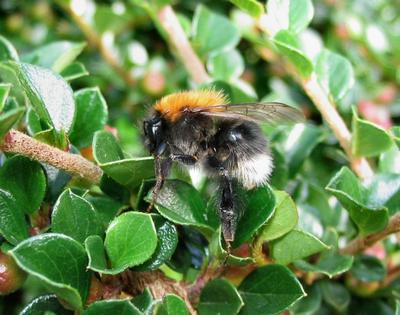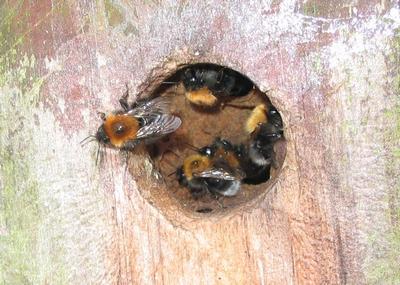Worcestershire Record No. 25 November 2008 p. 7
BOMBUS HYPNORUM
FOUND IN REDDITCH
Gary Farmer
 On the 29th June 2008 I was told by Bryan Batchelor that he had been
stung on his ear by a bumblebee in his garden. He reported that “brown
bumblebees” were nesting in a bird-nesting-box in his garden in Walkwood,
Redditch, and it was one of these that had stung him when he was mowing his lawn
and got too close to the nest. I was curious so the following weekend I went to
see the nest and was surprised to see very distinctive bumblebees with brown
thorax and black abdomen with white 'tail'. I was able to identify them
immediately as Bombus hypnorum, a species new to Worcestershire.
On the 29th June 2008 I was told by Bryan Batchelor that he had been
stung on his ear by a bumblebee in his garden. He reported that “brown
bumblebees” were nesting in a bird-nesting-box in his garden in Walkwood,
Redditch, and it was one of these that had stung him when he was mowing his lawn
and got too close to the nest. I was curious so the following weekend I went to
see the nest and was surprised to see very distinctive bumblebees with brown
thorax and black abdomen with white 'tail'. I was able to identify them
immediately as Bombus hypnorum, a species new to Worcestershire.

The nest was observed for a few weeks and it was noted that the entrance hole
was blocked up by the bees, leaving just two small holes for the workers to
enter and leave the nest box. On several occasions the material blocking the
hole was found to be broken away, and slug trails were evident entering the box.
During the day workers could be seen positioned around the entrance hole fanning
their wings presumably to move air into the nest. Also a much larger bumblebee
was seen occasionally leaving the nest to walk around the perimeter of the nest
box hole and then returning into the nest (presumably the queen B. hypnorum).
My attempts to photograph the bees at the nest hole resulted in some very close
encounters with fast-flying bees (but no stings!).
On 28th July 2008 the queen and a small worker were found dead on the lawn
and the nest hole had once more been broken open. There was now very little
activity around the nest and no attempt to repair the nest hole. By the 3rd
August there was no activity at the nest.
Having left the nest for a further two weeks we took the box down and removed
the top to see what had been going on. The box was full of strong webbing and a
concentrated mass of web in the top corner of the box contained pupa and larvae
of the Wax Moth Aphomia sociella. This moth lays eggs in the nest of bees
and wasps and the resulting larvae eat old cells and droppings to begin with but
then turn to feed on the bumblebee larvae. In this case they left no sign that a
bumblebee nest had ever been there.
 On the 29th June 2008 I was told by Bryan Batchelor that he had been
stung on his ear by a bumblebee in his garden. He reported that “brown
bumblebees” were nesting in a bird-nesting-box in his garden in Walkwood,
Redditch, and it was one of these that had stung him when he was mowing his lawn
and got too close to the nest. I was curious so the following weekend I went to
see the nest and was surprised to see very distinctive bumblebees with brown
thorax and black abdomen with white 'tail'. I was able to identify them
immediately as Bombus hypnorum, a species new to Worcestershire.
On the 29th June 2008 I was told by Bryan Batchelor that he had been
stung on his ear by a bumblebee in his garden. He reported that “brown
bumblebees” were nesting in a bird-nesting-box in his garden in Walkwood,
Redditch, and it was one of these that had stung him when he was mowing his lawn
and got too close to the nest. I was curious so the following weekend I went to
see the nest and was surprised to see very distinctive bumblebees with brown
thorax and black abdomen with white 'tail'. I was able to identify them
immediately as Bombus hypnorum, a species new to Worcestershire.